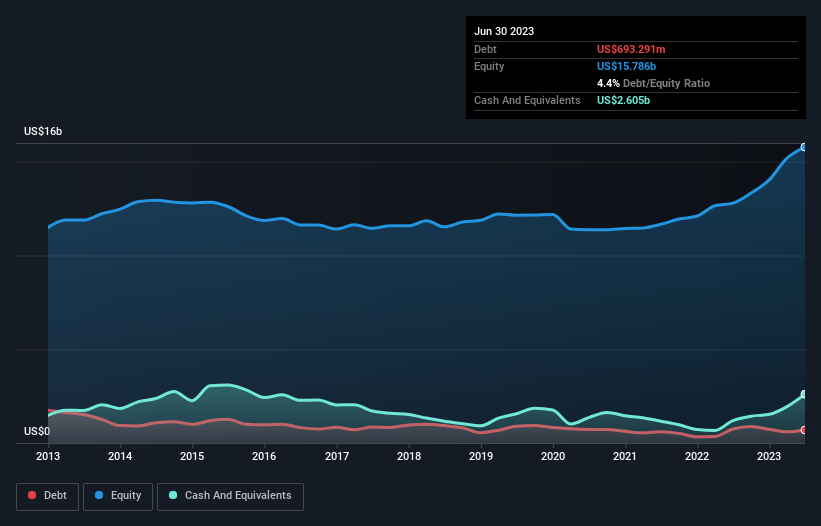
The external fund manager backed by Berkshire Hathaway's Charlie Munger, Li Lu, makes no bones about it when he says 'The biggest investment risk is not the volatility of prices, but whether you will suffer a permanent loss of capital.' When we think about how risky a company is, we always like to look at its use of debt, since debt overload can lead to ruin. We can see that Tenaris S.A. (BIT:TEN) does use debt in its business. But should shareholders be worried about its use of debt?
Why Does Debt Bring Risk?
Debt is a tool to help businesses grow, but if a business is incapable of paying off its lenders, then it exists at their mercy. In the worst case scenario, a company can go bankrupt if it cannot pay its creditors. However, a more usual (but still expensive) situation is where a company must dilute shareholders at a cheap share price simply to get debt under control. Of course, debt can be an important tool in businesses, particularly capital heavy businesses. The first step when considering a company's debt levels is to consider its cash and debt together.
View our latest analysis for Tenaris
How Much Debt Does Tenaris Carry?
As you can see below, Tenaris had US$693.3m of debt at June 2023, down from US$744.6m a year prior. But on the other hand it also has US$2.61b in cash, leading to a US$1.91b net cash position.

How Strong Is Tenaris' Balance Sheet?
Zooming in on the latest balance sheet data, we can see that Tenaris had liabilities of US$2.60b due within 12 months and liabilities of US$877.3m due beyond that. Offsetting these obligations, it had cash of US$2.61b as well as receivables valued at US$3.11b due within 12 months. So it actually has US$2.25b more liquid assets than total liabilities.
This short term liquidity is a sign that Tenaris could probably pay off its debt with ease, as its balance sheet is far from stretched. Simply put, the fact that Tenaris has more cash than debt is arguably a good indication that it can manage its debt safely.
Even more impressive was the fact that Tenaris grew its EBIT by 166% over twelve months. That boost will make it even easier to pay down debt going forward. When analysing debt levels, the balance sheet is the obvious place to start. But ultimately the future profitability of the business will decide if Tenaris can strengthen its balance sheet over time. So if you're focused on the future you can check out this free report showing analyst profit forecasts.
But our final consideration is also important, because a company cannot pay debt with paper profits; it needs cold hard cash. While Tenaris has net cash on its balance sheet, it's still worth taking a look at its ability to convert earnings before interest and tax (EBIT) to free cash flow, to help us understand how quickly it is building (or eroding) that cash balance. In the last three years, Tenaris's free cash flow amounted to 49% of its EBIT, less than we'd expect. That's not great, when it comes to paying down debt.
Summing Up
While it is always sensible to investigate a company's debt, in this case Tenaris has US$1.91b in net cash and a decent-looking balance sheet. And it impressed us with its EBIT growth of 166% over the last year. So is Tenaris's debt a risk? It doesn't seem so to us. There's no doubt that we learn most about debt from the balance sheet. But ultimately, every company can contain risks that exist outside of the balance sheet. For instance, we've identified 2 warning signs for Tenaris (1 is concerning) you should be aware of.
When all is said and done, sometimes its easier to focus on companies that don't even need debt. Readers can access a list of growth stocks with zero net debt 100% free, right now.
Valuation is complex, but we're here to simplify it.
Discover if Tenaris might be undervalued or overvalued with our detailed analysis, featuring fair value estimates, potential risks, dividends, insider trades, and its financial condition.
Access Free AnalysisHave feedback on this article? Concerned about the content? Get in touch with us directly. Alternatively, email editorial-team (at) simplywallst.com.
This article by Simply Wall St is general in nature. We provide commentary based on historical data and analyst forecasts only using an unbiased methodology and our articles are not intended to be financial advice. It does not constitute a recommendation to buy or sell any stock, and does not take account of your objectives, or your financial situation. We aim to bring you long-term focused analysis driven by fundamental data. Note that our analysis may not factor in the latest price-sensitive company announcements or qualitative material. Simply Wall St has no position in any stocks mentioned.
About BIT:TEN
Tenaris
Manufactures and distributes steel pipes for the energy industry and other industrial applications in North America, South America, Europe, the Middle East and Africa, and the Asia Pacific.
Flawless balance sheet, good value and pays a dividend.


